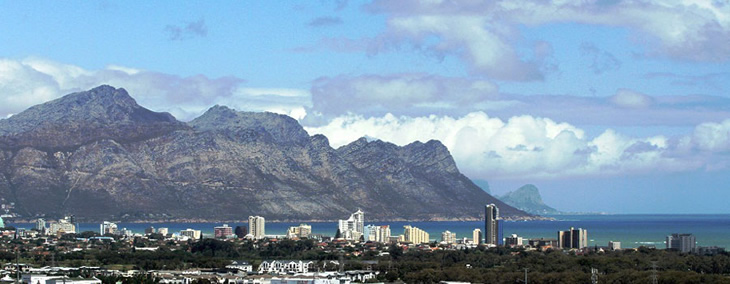The Helderberg is a wine-producing area in the Western Cape of South Africa. Originally it was known as the ‘Hottentots-Holland’ area but was renamed ‘Helderberg’ by the City of Cape Town.
The Helderberg is made up of Somerset West, Strand, Gordon’s Bay and a few other smaller towns. The district takes its name from the imposing Helderberg Mountain, which is Afrikaans for “Clear Mountain”, and culminates at a height of 1137m at The Dome.
Somerset West
A town encircled by exquisite mountains and hills covered in vineyards, with views of the nearby ocean and sandy beaches. It is a veritable paradise for all who appreciate scenic beauty, wine and fruit, decadent cuisine, hospitality, good taste and sense of history.
Somerset West was named after the British Governor, Lord Charles Somerset, in 1819. In 1817, four farmers who owned different parts of Vergelegen (meaning “remote”) in Somerset West asked the governor’s permission to build a church around which a village would be established. Permission was granted and the Somerset village was born. It later became Somerset West (1850), to prevent confusion with another town South African town Somerset East.
Somerset West has expanded greatly over the past decade, yet its splendor remains intact. The town is more industrious than ever and has become the commercial and residential capital of the Helderberg Basin. Quaint buildings in side streets are delightful features of our historic town filled with delightful boutiques offering wine, flowers, chocolates, books, fabrics, jewelry, antiques – anything you find essential and everything you require for afternoon’s diversion.
Somerset West enjoys a Mediterranean-like climate. Winter can be unpredictable since its rainy periods are often interjected with many sunny days. Somerset West summers are dry and hot tempered by soothing sea breezes. Spring and Autumn are idyllic, with mild days and warm evenings.
Somerset West offers excellent educational institutions from pre-school to tertiary level. As a holiday destination it is superb: close to all the famous attractions that make the Cape one of the top 3 holiday destinations in the World. Somerset West caters for sport lovers with golf courses, sport clubs as well as establishments offering horse rides, cycling, running, mountain biking, hiking and many more.
Strand
A seaside resort town situated on the eastern edge of False Bay and at the foot of the Hottentots Holland Mountains. Its geographical position is just between Macassar and Gordon’s Bay, and is about 50 km southeast of Cape Town. Strand’s main attraction is the beach; 5 km of white sandy beach lapped by the waters of False Bay.
History – Strand was founded in 1714 and originated as a holiday and fishing village. It is now regarded as part of the greater city of Cape Town itself. Recent expansion of Somerset West and Strand have resulted in the two towns to be adjacent to each other, with shopping malls and residential complexes creating the connections. Strand forms part of the Helderberg Basin, together with Somerset West and Gordon’s Bay. It has great views of the Cape Peninsula and fine beaches.
Strand once accommodated one of the largest dynamite factories in South Africa. The dynamite factories were owned by the AECI group. This area is being redeveloped into a large new mixed-use urban development, Paardevlei.
Tourism – The main beach in the Strand, Melkbaai Beach, is known to be one of the best and safest bathing areas in the country. Facilities on or nearby include Dune Park with a super tube and mini-golf and Harmony Park, which boasts a huge tidal pool. Water sports may be conducted from various points along the beachfront. The coast between the Lourens River mouth and up to Rooi Els is very popular with beach fishermen and rock anglers, whilst organized and social diving activities beckon the more adventurous.
Gordon’s Bay
A harbor town close to Strand situated on the northeastern corner of False Bay about 50 km from Cape Town and is named after Robert Jacob Gordon (1743–1795), the Dutch explorer of Scottish descent.
Gordon’s Bay is the smallest of three towns in the Helderberg region, so named after the Helderberg Mountain, which is part of the Hottentots-Holland Mountains dwarfing the locality on two sides. Gordon’s Bay was originally named “Fish Hoek”, many years before the town of the same name, located on the western side of False Bay, was founded. Evidence of this can be seen on the outside wall of the local Post Office.
Gordon’s Bay consists of the old village, situated around the old harbor and Bikini Beach, the mountainside on the lower slopes of the Hottentots-Holland mountains overlooking False Bay, and the low-lying suburbs close to the main beach, making up the most recent expansion of the town.
The older part of Gordon’s Bay is host to the South African Navy’s Naval College, an officer training center located adjacent to the old harbor and yacht marina. Above the harbor on the mountainside is a giant anchor and the letters “GB”. Many think that this stands for Gordon’s Bay, but in fact it stands for General Botha, which was the original name of the Naval station in the town.
The Steenbras Dam, Cape Town’s primary supply of drinking water, is located on the mountain above the town.
Gordon’s Bay is host to one of the few blue flag beaches in South Africa, Bikini Beach. The beach is also considered safe with regular patrols from a seasonal security guard.



